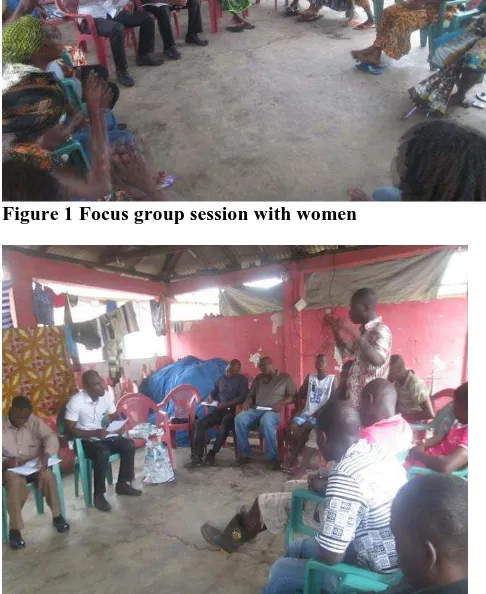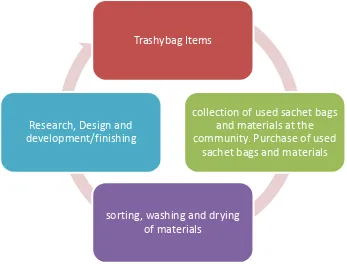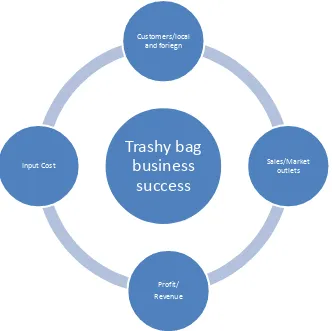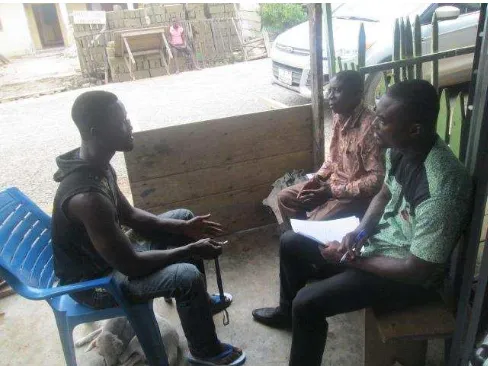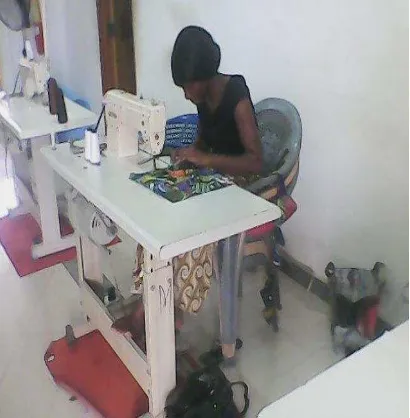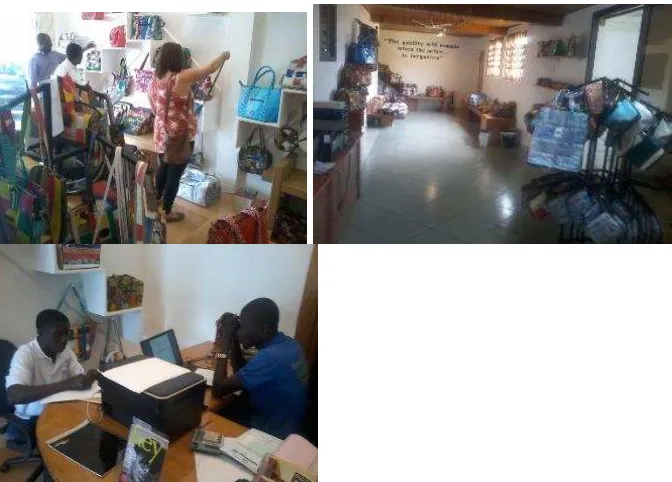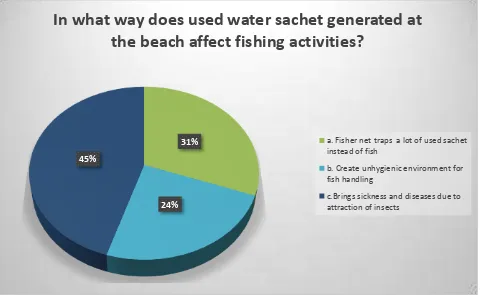SUSTAINABLE FISHERIES
MANAGEMENT PROJECT (SFMP
)
Report On Sanitation Assessment To
Explore Opportunities And Viability Of
This publication is available electronically on the Coastal Resources Center’s website at http://www.crc.uri.edu/
For more information on the Ghana Sustainable Fisheries Management Project, contact:
USAID/Ghana Sustainable Fisheries Management Project Coastal Resources Center
Graduate School of Oceanography University of Rhode Island
220 South Ferry Rd.
Narragansett, RI 02882 USA
Tel: 401-874-6224 Fax: 401-874-6920 Email: [email protected]
10 Obodai St., Mempeasem, East Legon, Accra-Ghana Tel: +233 (0) 244678007
P.O.Box WY1049, Kwabenya - Accra, Ghana
Citation: Swanzy, S. (2015). Report on Sanitation Assessment to Explore Opportunities and
Viability of Trashy Bag Business at Ankobra Estuaries. The USAID/Ghana Sustainable Fisheries Management Project (SFMP). Narragansett, RI: Coastal Resources Center, Graduate School of Oceanography, University of Rhode Island and Daasgift Quality Foundation. GH2014_ACT024_DQF. 29pp.
Authority/Disclaimer:
Prepared for USAID/Ghana under Cooperative Agreement (AID-641-A-15-00001) awarded on October 22, 2014 to the University of Rhode Island and entitled; the USAID/Ghana Sustainable Fisheries Management Project (SFMP).
Detailed Partner Contact Information:
USAID/Ghana Sustainable Fisheries Management Project (SFMP) 10 Obodai St., Mempeasem, East Legon, Accra, Ghana
Brian Crawford Chief of Party [email protected]
Najih Lazar Senior Fisheries Advisor [email protected]
Patricia Mensah Communications Officer [email protected] Bakari Nyari Monitoring and Evaluation Specialist [email protected]
Don Robadue, Jr. Program Manager, CRC [email protected]
Justice Odoi USAID Administrative Officer Representative [email protected]
Kofi.Agbogah
SNV Netherlands Development Oganization #161, 10 Maseru Road,
E. Legon, Accra, Ghana 233 30 701 2440
Donkris Mevuta Kyei Yamoah [email protected] Friends of the Nation Parks and Gardens Adiembra-Sekondi, Ghana 233 312 046 180
Peter Owusu Donkor Spatial Solutions
[email protected] #3 Third Nautical Close,
Nungua, Accra, Ghana
Darkuman Junction, Kaneshie Odokor Highway
Headmaster residence, Sekondi College Sekondi, Western Region, Ghana 233 243 326 178
For additional information on partner activities: CRC/URI: http://www.crc.uri.edu CEWEFIA: http://cewefia.weebly.com/
DAA: http://womenthrive.org/development-action-association-daa Daasgift:
https://www.facebook.com/pages/Daasgift-Quality-Foundation-FNGO/135372649846101 Friends of the Nation: http://www.fonghana.org Hen Mpoano: http://www.henmpoano.org
SNV: http://www.snvworld.org/en/countries/ghana SSG Advisors: http://ssg-advisors.com/
ACRONYMS
CEDECOM Central Region Development Commission
CEWEFIA Central and Western Region Fishmongers Improvement Association CLaT Child Labour and Trafficking
DAA Development Action Association DSW Department of Social Welfare FoN Friends of Nation
SFMP Sustainable Fisheries Management Program SNV Netherlands Development Organization
TABLE OF CONTENTS
ACRONYMS ... ii
CHAPTER ONE ... 1
1.1 Introduction ... 1
1.2 Purpose of Assessment Report... 2
1.3 Goal ... 2
CHAPTER TWO ... 3
2.1 Methodology 1 - Focus Group Discuss - Ankobra ... 3
2.2. Results ... 4
2.3 Methodology 2 - Interviews with Entrepreneurs and Market outlets ... 4
2.4 Trashy Bag Business Production Process ... 5
2.5 Profitability ... 5
2.6 Trashy Bag Business Success Cycle ... 5
2.7 Customers ... 6
2.8 Inputs Costs ... 6
Sales Price ... 6
Profit Margin ... 7
Production level ... 7
2.9 Demographics of Producers ... 7
2.1.0 Challenges ... 10
2.1.1 Interviews with community members - Individuals ... 10
2.1.2 Analysis of Respondents - Axim ... 10
2.1.3 Results in general ... 21
CHAPTER THREE ... 22
3.1 Business Model ... 22
CHAPTER FOUR ... 23
4.1 Conclusions ... 23
References ... 23
LIST OF TABLES Table 1 Age distribution of respondents ... 4
Table 2 Gender disaggregation of respondents ... 4
Table 3 Demographic of respondents ... 4
Table 4 Respondents and Age distribution of respondents ... 7
LIST OF FIGURES
Figure 1 Focus group session with women ... 3
Figure 2 Focus group session with the youth... 3
Figure 3 Trashy Bag Production Process ... 5
Figure 4 Trashy Bag Business Success Cycle ... 6
Figure 5 Interview with Frank – manufacturer at Busua ... 8
Figure 6 A customer at an outlet at Osu- Accra during the study ... 8
Figure 7 A designer at Trashy Bag Accra showing a pencil case and laptop sleeve ... 9
Figure 8 One of the workers at Trashy Bag Accra busily working ... 9
Figure 9 Trashy bag Items on display at the market or sales outlet in Accra – Osu. ... 10
Figure 10 Questionnaire Response 1 ... 11
Figure 11 Questionnaire Response 2 ... 12
Figure 12 Questionnaire Response 3 ... 13
Figure 13 Questionnaire Response 4 ... 14
Figure 14 Questionnaire Response 5 ... 15
Figure 15 Questionnaire Response 6 ... 16
Figure 16 Questionnaire Response 7 ... 17
Figure 17 Questionnaire Response 8 ... 18
Figure 18 Questionnaire Response 9 ... 19
Figure 19 Questionnaire Reponse 10 ... 20
Figure 20 Questionnaire Response 11 ... 21
CHAPTER ONE
1.1 Introduction
Economic growth and changing consumption and production patterns are resulting into increase in generation of plastic waste in the world, (Fobi, 2000).
The world’s annual consumption of plastic materials has increased from around 5 million tons in the 1950s to nearly 100 million tons: thus, 20 times more plastic is produced today than 50 years ago, (UNEP 2009).
The rapid growth of plastic waste is not different in Ghana and for that matter all the coastal communities in the Western Region. The plastic waste in the coastal communities, including Axim and Ankobra (Ankobra estuary) present a dilemma.
Presently, drinking water comes in plastic bags and bottles. With strong taste for sachet water considering its portability, easy to carry from one place to another and the perception of its cleanliness has made sachet water more acceptable at public function and for domestic use. Ironically, after drinking the liquid content, those bags are disposed of indiscriminately thereby littering the surroundings across cities, big towns and especially, the coastal communities. According to a study by Oteng-Ababio, 2011, used water sachet bags, in other words plastic waste constitute a major proportion of the plastic waste generated throughout the country.
Managing plastic waste is a serious challenge to the local authorities as well as community leaders. In spite of its effects on the environment and associated health implications, water sachet bags can provide a very good economic and
social development. Quoting from a study by (GTZ 2000), “despite the health
and environmental effects associated with plastic waste, it is a great resource that can have very positive economic and social implications for the general
citizenry, but this has not been adequately exploited”. The study recognized the
potential of plastic waste, when fully exploited could be a source of alternative livelihood.
Daasgift under a contract signed with Sustainable Fisheries Management Project (SFMP) being sponsored by University of Rhode Island (URI) and United State Agency for International Development (USAID) Ghana, and in line with Daasgift deliverables under intermediate result (IR 4.5), conducted Sanitation Assessment to explore opportunities for Trashy Bag business development and coordinating community contacts.
The Sanitation Assessment revealed willingness of the people to collect plastic waste for a fee and described their desire to help sanitize the various landing sites.
Fish processors showed their preparedness to use recycled plastic materials
“fish mat” at the landing site and at the various processing points to provide healthy fish.
The study provided insightful knowledge about the huge potential of Trashy Bag business. One underlining issue that featured was education, thus, entrepreneurs recommended that people should be educated to segregate organic waste from plastic waste.
In summary almost all the contacts made at Axim and Sanwoma expressed their willingness to collect plastic waste for recycling. In another development, all the fish processors engaged in the discourse were also willing to use recycled material in the course of fish processing to provide healthy fish.
1.2 Purpose of Assessment Report
The aim of this report is therefore for DAASGIFT, under the SFMP project, carry out sanitation assessment as part of Intermediate Result 4 (IR4) Integrated Community Fisheries Management and Resilience Plans for the Ankobra River Estuarine and Mangrove Ecosystem to explore opportunities and viability of Trashy Bag business, bring to bear some of the hiding economic capability associated with plastic waste collection and recycling, create linkages, drawing on experiences of Trashy Bag producers in Accra and Western Region.
The assessment report is also to establish facts, figures, observation and technical issues that informed decision and way forward based on the methodology adopted. The report addresses concerns and provides alternative ideas with regard to the exercise.
The report again is to provide information on the extent to which insanitary condition at landing sites affect fishing activities in Ankobra estuary.
1.3 Goal
The objective of the sanitation assessment is to find appropriate strategy to develop livelihood empowerment programme and improve the livelihood of the target group especially women in the Ankobra estuary. It is also to ensure clean environment through sustainable collection and recycling of plastic waste by reducing pollution through indiscriminate disposal of plastic waste at the landing sites.
Secondly, to assess the viability of Trash bag business and opportunities it offers should one invest in the business.
Specifically, the sanitation assessment looks at:
1) The effect of plastic waste on fishing at the various landing site of Ankobra estuary and the collective responsibility to safeguard the environment.
3) Solicit the willingness of the people, thus, the youth, women and men to collect plastic waste as an alternative livelihood.
4) Assess the viability of Trashy Bag business and using it as a tool for alternative livelihood improvement.
CHAPTER TWO
2.1 Methodology 1 - Focus Group Discuss - Ankobra
Considering the prevailing status of the plastic waste in Axim and Ankobra, the two densely inhabited fishing communities in Nzema East Municipality, and Ellembelle Districts, focus group discussion and key informant interviews were adopted. Focus group discussion was concentrated at Ankobra. Documented sources were slightly used to establish and corroborate where possible, the primary data collected. The assessment focused mainly on qualitative and quantitative approach to gather in-depth information. Proceedings at the Focus
group were mainly in the local language “Twi” and “Nzema”, which were
translated, analysed and organised around the key themes that emerged from the FGDs.
Figure 1 Focus group session with women
2.2. Results
Description of the Results
Focus Group Discussion at Ankobra
Table 1 Age distribution of respondents
Age Number
Source: Sanitation Assessment Data 2015
From table 1, out 75 respondents, 25 representing 33.33 percent were in the age
range of 18 – 35, and 50 representing 66.67 percent were in the age range of 36
– 59.
Table 2 Gender disaggregation of respondents
Gender Number
Source; Sanitation Assessment Data 2015
From table 2, out of 45 respondents, 25 representing 56 percent were male, 20 representing 44 percent were female.
Table 3 Demographic of respondents
Occupation Number
Source; assessment data 2015
From table 3, out of 75 respondents, 25 representing 33.33 percent were fishermen, 50 representing 66.77 percent were fishmongers.
2.3 Methodology 2 - Interviews with Entrepreneurs and Market outlets
on kind of products produced and marketing outlets of trashy bags including business prospects. In all, ten entrepreneurs of trashy bags were interviewed and they have been in business for more than five years.
2.4 Trashy Bag Business Production Process
Figure 3 Trashy Bag Production Process
The designer at Trashy Bag - Accra explained the process and mentioned research as a tool to gather information about customer needs and kinds of materials to use in order to satisfy customers.
2.5 Profitability
As businesses thrive on profit maximization, the study looked at five sales outlets to ascertain facts on market and trend of sales of the various products. These interactions revealed the fast moving items as; Azonto ladies bags, school
bags, smart bags, laptop sleeves, hat and pencil case. Though the sales persons
were not ready to provide profit margin per every item, the search showed, that profit margin per Azonto Ladies bag is 30 Ghana cedis and that of Smart bag is
25 Ghana Cedis, depending on the brand.
2.6 Trashy Bag Business Success Cycle
Trashybag Items
collection of used sachet bags and materials at the community. Purchase of used
sachet bags and materials
sorting, washing and drying of materials
Figure 4 Trashy Bag Business Success Cycle
2.7 Customers
According to the producers interacted with, the customer is placed at the top of the business cycle. Thus, to continue to remain in business, the customer is always the focus and that trashy items are designed to satisfy the needs of the customer.
A customer who was met at the Osu outlet expressed her joy seeing plastic
waste turned into beautiful items and stated “there is market for waste plastics
in China which can be explored for export.”
Customers who supply inputs (used Sachets materials) to produce the final products are motivated to supply hygienic and useful materials.
2.8 Inputs Costs
Information gathered indicated that, inputs cost for Smart Bag and Azonto bag is 10 and 15 Ghana Cedis respectively. On the average, the total cost of production for Smart and Azonto bag is between 20 and 30 Ghana Cedis respectively.
Sales Price
At the market outlets, Smart and Azonto bags are sold between 50 and 60 Ghana Cedis respectively.
Profit Margin
Comparing cost of production per Smart and Azonto bag to its sales price, the profit margin is between 25 and 30 Ghana Cedis per sale of one Smart or Azonto bag.
Production level
On the average, 10 to 15 smart bags are produced a day by an employee when all the needed materials are readily available.
2.9 Demographics of Producers
Table 4 Respondents and Age distribution of respondents
Age Respondents Percentage Cumulative
Percentage
18 -35 7 70 70
36 – 59 3 30 100
Total 10 100
Source; assessment data 2015
From table 4, out of 10 respondents, 7 representing 70 percent were within age
Table 5 Respondents and Proportion of sex of respondents
Gender Respondents Percentage Cumulative
Percentage
Male 7 70 70
Female 3 30 100
Total 10 100
Source; assessment data 2015
From table 5, out 10 respondents, 7 representing 70 percent were male and 3 representing 30 percent were females.
Figure 5 Interview with Frank – manufacturer at Busua
Figure 7 A designer at Trashy Bag Accra showing a pencil case and laptop sleeve
Figure 9 Trashy bag Items on display at the market or sales outlet in Accra – Osu.
2.1.0 Challenges
Entrepreneurs mention some challenges they face and that includes washing of sachet bags which sometimes leads to fading of the sachet rubber due to its poor quality. Again, because organic waste are mixed with plastic waste, most of the sachet rubbers become so dirty and that creates a lot of work.
2.1.1 Interviews with community members - Individuals
A total of four hundred people were involved in the sanitation assessment. They included 45 community members at Sanwoma who were engaged in focus group discussion, comprising 15 youths, 15 females between the age of 36 and 59 and also 15 males between the age of 36 and 59, and thirty (30) individuals who were interviewed one on one. Three hundred and ten 310 people of Axim were also interviewed, while 10 producers of trashy bags and 5 outlets were interacted with.
2.1.2 Analysis of Respondents - Axim
Figure 10 Questionnaire Response 1
Source; assessment data 2015
From figure 10, out of 310 respondents, 95 representing 31% were of the view that a lot of used water sachet or plastic materials are trapped in the fisher nets whenever fishermen drag their nets at sea to catch fish and they waste much time to remove them, 75 representing 24% stated, used water sachet generated at the beach create unhygienic environment and 140 representing 45% said most of the sicknesses or diseases affecting the community were as a result of breeding of insect and Mosquitoes in the used sachet water bags at the landing sites.
31%
24% 45%
In what way does used water sachet generated at
the beach affect fishing activities?
a. Fisher net traps a lot of used sachet instead of fish
b. Create unhygienic environment for fish handling
Figure 11 Questionnaire Response 2
Source; assessment data 2015
From figure 11 out of 310 respondents, 194 representing 63% said the fishermen and their associates including members of the community litter after drinking and in most cases members of the community use the landing beaches as their dumping site or waste disposal site.116 representing 37% were of the view that sales outlets of sachet water at the beach and drainage system in the community which have their outlet at the beach contribute to the menace. Littering anyhow, culminating with numerous sachet water producers supplying along the landing site with their vehicles were also mentioned.
63% 37%
What are the sources of these used water
sachet?
a. indiscriminate dumping of refuse from various homes
Figure 12 Questionnaire Response 3
Source; Assessment data 2015
From the figure 12, out of the 310 respondents, 154 representing 50% mentioned the possible ways to manage used water sachet is to recycle, 65 representing 21% suggested collection and gathering into sacks or instituting a regulatory measures to check those who dispose of them, whiles 91 representing 29% suggested special bins be made available for collection and disposal.
21%
50% 29%
What are the possible ways to manage used
water sachet?
a. collection and gathering or institute a regulatory measures
b. Recycling
Figure 13 Questionnaire Response 4
Source: assessment data 2015
From Figure 13, 120 out of 310 respondents representing 39% are aware of alternative uses of used water sachet whiles 190 respondents representing 61% are not aware of any alternative uses of used water sachet.
39%
61%
Are you aware of any alternative uses of used
water sachet?
Figure 14 Questionnaire Response 5
Source; Assessment data 2015
From Figure 14 above, , 190 out of 310 respondents representing 61% were not able to mention or name some alternative uses of used water sachet whiles 120 respondents representing 39% named alternative uses of used sachet bags.
61% 39%
Can you name some alternative uses?
can't mention
Figure 15 Questionnaire Response 6
Source: assessment data 2015
From figure 15, all the 310 respondents, representing 100% said they would like to collect used water sachet as additional income generating venture.
100%
Would you like to collect used water sachet
as additional income generating venture?
Figure 16 Questionnaire Response 7
Source: assessment data 2015
From figure 16 out of 310 respondents, 48 representing 15% , expected 2ghc per 50kg sack of used water sachet collected, 139 representing 45% , expected 5ghc per 50kg sack of used water sachet collected, 130 representing 39% , expected 10ghc per 50kg sack of used water sachet collected and 3 representing
1% expected between 20 – 100ghc.
15%
45% 39%
1%
How much do you expect per 50kg sack of used
water sachet collected?
Figure 17 Questionnaire Response 8
Source: assessment data 2015
From figure 17 out of 310 respondents, 120 representing 39% did say yes to have seen some products made out of used water sachet before as mentioned in figure 5 whereas 190 representing 61% said no.
39%
61%
Have you seen some products made out of used
water sachet before?
Figure 18 Questionnaire Response 9
Source: assessment data 2015
From figure 18, all the respondents said they have not used trashy products before.
100%
Have you ever used trashy products mentioned
or shown before?
Figure 19 Questionnaire Reponse 10
Source: assessment data 2015
From figure 19, none of the total respondents of 310 have ever used trashy product before as asked in figure 9 above and that makes it not possible for the respondents to express their likeness or satisfaction from the use of trashy products.
0% 0%
Figure 20 Questionnaire Response 11
Source: assessment data 2015
From figure 20, out of total respondents of 310, all of them are ready and would like to use products of used plastic items.
2.1.3 Results in general
Information gathered and analysed provided the following results:
All the target groups and individuals interviewed and interacted with alluded to the fact that plastic waste has a serious implication on the environment, especially at landing sites.
Almost all the three hundred and forty community members interviewed including the forty-five youth, men and women who participated in the focus group discussions showed their willingness to collect the plastic waste for a fee, and the amount expected per 50kilo bag ranges from Two (2) and Ten (10) Ghana cedis, with Twenty (20) to One hundred (100) Ghana cedis as the highest fee per 50kilo bag.
Interactions with five entrepreneurs in Accra, Apowa, Busua and Dixcove revealed that Trashy Bag business has a huge potential but what is needed is education on segregating plastic waste from organic waste.
The entrepreneurs’ and sales outlets revealed the following as the fast moving items; Azonto ladies bags, school bags, smart bags, laptop sleeves, hat and pencil case.
Upon seeing the kind of items derived from recycled materials, fish processors and all those interviewed in the communities expressed their desire to use
100%
If no, would you like to use products of used
plastic items?
especially, plastic mat, and were excited to see school bags made out of plastic waste.
Fifteen (15), - 4% of members of Ankobra and Axim community would want to be trained on the production of trashy bags.
CHAPTER THREE
3.1 Business Model
With the above results, the study finds the under mentioned business model as appropriate tool to develop the Trashy Bag business and tackle the sanitation problem at the landing sites where the study was conducted.
The business model provides a holistically approach and will yield better result in terms of improving the livelihood of the people, profitability, social- inclusiveness, and knowledge management (community sensitization and local resource planning).
Figure 21 Trashy Bag Business Model
Community /
CHAPTER FOUR
4.1 Conclusions
Based on the data and analyses made in respect of sanitation assessment, the result has shown that plastic recycling activities have economic benefit and thus would provide an important livelihood support.
The results of the assessment has also shown that apart from individual incomes that could accrued from the collection and sale of plastics waste, the landing sites stand to benefit through waste minimization and would have a rippling effect on fishing at the various landing sites. Aside hundreds of individuals willing to collect plastic materials as another livelihood venture, 15, that is, 4% of the community members are willing to be trained to produce trashy bags. The high degree of labour intensity of the waste picking and sorting processes will enable hundreds of people to earn income and thus reaping the economic benefit of the system, thus, 96% of the respondents stand to benefit immensely. The assessment concludes that owing to the great potential of plastic recycling and Trashy Bag business for both local and international market, investing in the business would provide alternative livelihood to the people and help sanitize the landing sites in the Ankobra Estuary.
REFERENCES
Fobil J. N. (2000). Municipal Solid Waste Characterization for Integrated Management in the Accra Metropolis, (MSc. Thesis.), University of Ghana, Legon, Accra.
GTZ, (2000): Urban management advisory service, Addis Ababa. Current issues: Urban development, land management. Formal and informal investment. Addis Ababa.
Oteng- Ababio,( 2011): Beyond technical details: The stalled Kwabenya Engineered Sanitary Landfill Project in Accra, Ghana. Accra Ghana
Owusu-Sekyere e’tal (2013): An Analysis of the Plastic Waste Collection and
